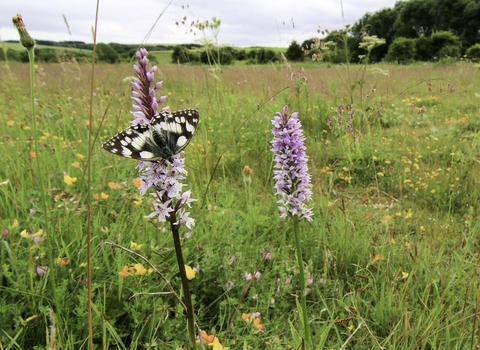- Widespread misuse of Biodiversity Net Gain (BNG) exemptions by large and small developers meant 86% of all approved planning applications claimed exemptions in the scheme’s first year.[1]
- New research shows this would worsen to 97% of all approved planning applications claiming exemptions from Biodiversity Net Gain, if all small developments were taken out of scope of BNG and loopholes aren’t closed - jeopardising nature recovery.
- Government proposals to remove BNG rules for all small developments would also inhibit green growth, by drastically reducing the scope of the biodiversity unit market. Allowing developers to avoid biodiversity compensation obligations of £250 million per year.
- The report proposes an alternative to reduce burdens for 50,000+ of the smallest developments each year, while also closing loopholes that allow larger developers to sidestep the scheme. This would double the area of land contributing to nature recovery through BNG (an additional 20,552 hectares) and double the size of the biodiversity market, as compared to Government proposals to exempt all small sites.
Environmentalists and economists are urging the Government to abandon damaging proposals (currently under consultation) to exempt all small development sites (under 1 hectare) from crucial biodiversity requirements. The call comes as new research, BNG in Small Developments, highlights this would be a major setback for nature recovery and risks collapsing the emerging biodiversity credits market.[2] Instead, the research shows that by removing the very smallest sites (under 0.1ha) from the scheme altogether but ending loopholes for larger sites, a “win-win” could be achieved for nature and development.
New analysis by eftec, commissioned by The Lifescape Project and Wildlife and Countryside Link, shows the extent of current BNG rule misuse and the likely future impacts if the Government removes BNG requirements for all small sites:
- 69,500 out of 80,400 approved planning applications for large and small new domestic and commercial developments (86%) claimed exemptions from BNG requirements in the first year of the scheme.[3] These exemptions allow developers to “self-declare” whether an application would have an effect on nature.
- Despite being originally intended to apply to “most” planning applications, an estimated 76,800 out of 79,300 approved planning applications per year (97%) would be likely to claim exemption from BNG rules, if all small sites are excluded from BNG.[4] This would dramatically reduce the effectiveness of the BNG policy in compensating for biodiversity loss and render it utterly ineffective compared to what was promised.
- As a result of all small-site exemptions, and with ongoing loopholes in the scheme for small and large developers, then 215,500+ha (an area around the size of the Yorkshire Dales or Snowdonia), would be built on by developers without having to compensate for any of the biodiversity they destroy.[5]
- Current exemptions and poor enforcement are allowing developers to avoid biodiversity compensation obligations worth £180 million per year (based on expected Biodiversity Unit prices). If all small sites are exempted this is estimated to increase to £250 million per year.[6]
- Only 6,504 Biodiversity Units would be generated for compensation payments by developers (large and small) if all small sites are BNG exempt and poor implementation continues. Half the size of the biodiversity market when compared to 13,364 Biodiversity Units being paid for if a 0.1ha very small site exemption and stricter BNG rule enforcement was implemented instead.
Richard Benwell, CEO of Wildlife and Countryside Link, said: “Biodiversity Net Gain is a hugely important principle: industries that harm nature should contribute to its recovery. The proposal to drastically widen the number of exempt small sites from the system would be a return to the bad old days of damaging development and torpedo confidence in private investment in nature recovery. eftec’s research shows that by removing only the very smallest sites from the system while closing loopholes for larger developments, the Government could make sure Biodiversity Net Gain works for nature as it was intended, as well as benefiting the genuinely small-scale developments that don’t pose a threat to nature.”
Adam Eagle, CEO of The Lifescape Project, said: “As a Responsible Body, we are fully invested in ensuring that the BNG market functions properly and we see it as a key tool to drive more funds into nature restoration. We have had concerns for some time about poor implementation and issues with policy design. However, the proposed changes won’t fix this. Exempting all small sites from BNG rules will let thousands of builders demolish nature without paying for the damage, and we will all foot the repair bill, while wildlife pays the price with silence. The Government’s proposals are reckless for nature and for taxpayers and are bad for business too as they will bulldoze an emerging and innovative biodiversity credit market.”
Joan Edwards, director of policy and public affairs at The Wildlife Trusts, says: “The UK Government has promised to create a win-win for nature and development but scrapping Biodiversity Net Gain for small sites would be a spectacular own goal in trying to achieve this. The proposals come one year into biodiversity net gain, just as key players – from landowners and farmers, to developers and nature organisations – have got to grips with the requirements. Nothing undermines private-sector confidence more than a government that chops and changes the rules on a whim. Ministers should ditch the reckless idea of exempting small sites from BNG and focus on bolstering support for small housebuilders to access nature markets so that their developments can deliver for people and for wildlife.”
Gemma Cantelo, head of policy and advocacy for RSPB England, said: “The UK Government’s proposal to exempt small developments from BNG rules rather than knuckle down and fix existing issues would pull the rug out from under nature and industry. Declining habitats and wildlife need support to recover, while investors require certainty. A solution that fails everyone isn’t much of a solution at all.”
Small sites dominate planning in England: currently, around 95% of planning applications are for sites under 1 hectare, 88% are under 0.5 hectares and 77% are for sites under 0.2 hectares. These substantial figures show the central role of small sites in delivering nature gains and in making biodiversity units a viable new market.
With such a large proportion of development being taken out of the vital BNG scheme by small site exemption, it will jeopardise the UK’s ability to meet the legally binding Environment Act target of halting species decline by 2030 and globally important target to protect 30% of land and sea for nature. Environment groups say BNG is the second most important funding stream for environmental restoration, after nature-friendly farm funding, and these moves will critically undermine the viability of the BNG scheme.
Government has said investment from the private sector is crucial to meet the gap in funding needed to meet binding nature recovery targets. With Secretary of State Steve Reed last month (12 June) urging the importance of private finance in funding the protection and restoration of nature. Yet exempting all small sites from BNG could destroy the biodiversity market’s viability.
The report shows that a small change to BNG rules would improve efficacy. It suggests replacing the proposed universal small site exemption with a simple, clear rule: exclude only sites of up to 0.1 hectares that align with the Government’s proposed new definition of "very small sites". This would also remove the current loophole that allows some very large sites to side-step BNG entirely.
This alternative approach is a win-win: it would result in the vast majority - more than 50,000 of the smallest sites - being exempted from BNG altogether. But at the same time, by bringing all small sites over 0.1ha back in scope of BNG and by ending the loopholes used by very large sites, it would result in 20,552 more hectares of development being covered by BNG requirements and protected for nature compensation than under Government plans.[8] As a result, the biodiversity unit market would be twice the size that it would be under the Government’s proposals (13,364 biodiversity units created versus 6,504).[9]
Collectively, this would help to protect the majority of green space impacted by development, target efforts where the risk to biodiversity is greatest, ease burdens on small developers and self builders, and support a more stable and effective biodiversity market.

